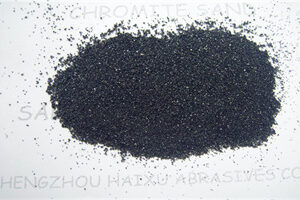Different sizes chromite powder react with different elements to produce different colors

Different sizes chromite powder will show various color characteristics due to differences in composition and changes in the valence state of chromium when reacting with different elements, as follows:
1. Types of chromite powder and basic colors
Chromite
The main components are chromium, iron, magnesium, etc., often black or dark green, with brown streaks and semi-metallic luster.
Chromium chlorite
A chromium-containing silicate mineral, the color changes with the chromium content, commonly green, brown or gray-green, with glass to pearl luster.
2. Chromium valence state and reaction color
Chromium presents typical colors when combined with specific elements in different valence states:
Cr³⁺ (trivalent chromium)
Reacts with hydroxyl groups: produces gray-blue Cr(OH)₃ precipitate or green Cr(OH)₄⁻ solution.
Combined with chloride ions: forming different hydrates, such as [Cr(H₂O)₆]³⁺ (purple), [CrCl₂(H₂O)₄]⁺ (green), etc.
Sulfate: Cr₂(SO₄)₃ is pink, and its hexahydrate is green crystals.
Cr⁶⁺ (hexavalent chromium)
Chromate (CrO₄²⁻): yellow (such as K₂CrO₄) .
Dichromate (Cr₂O₇²⁻): orange-red (such as K₂Cr₂O₇) .
Cr²⁺ (divalent chromium)
Chloride: CrCl₂ solution is blue, and reacts with acetate to form red chromium acetate (containing Cr-Cr quadruple bond) .
3. Color changes in application scenarios
Glass coloring
Chromite powder reacts with silicon, sodium and other materials at high temperatures to generate green, brown or black coloring ions (such as Cr³⁺ doping).
Ceramic glaze
Chromium elements combine with other metal oxides to form metallic glazes such as blue and green.
Redox reaction
In an acidic environment, Cr₂O₇²⁻ (orange-red) is reduced to Cr³⁺ (green); under alkaline conditions, CrO₄²⁻ (yellow) and Cr₂O₇²⁻ (orange-red) can be converted into each other.
4. Influencing factors
Chromium content: High chromite powder is more likely to generate high-saturation colors (such as dark green and orange-red).
Reaction environment: pH, temperature and ligand type affect the coordination structure of chromium, resulting in color differences (such as color changes of isomers of chromium chloride hydrate).
The above color characteristics are the important application basis of chromite powder in industry and chemistry.
Haixu Abrasive Factory can produce chromite powder the following sizes:
180 mesh (85 microns), 200 mesh (75 microns), 270 mesh (53 microns), 325 mesh (45 microns), 400 mesh (38 microns), 500 mesh (25 microns), 600 mesh (23 microns), 800 mesh (18 microns), 1000 mesh (13 microns), 1200 mesh (12 microns), 1500 mesh (10 microns), 1600 mesh (9 microns), 1800 mesh (8 microns), 2000 mesh (6.5 microns), 2200 mesh (6 microns), 2500 mesh (3-5 microns)




















